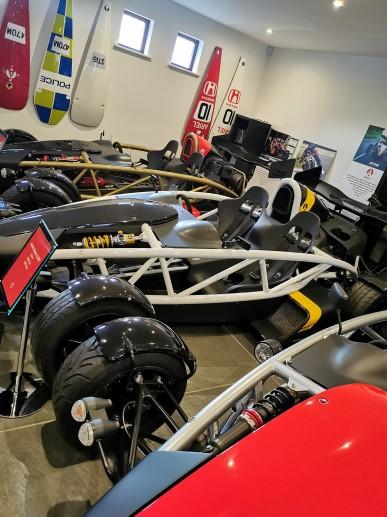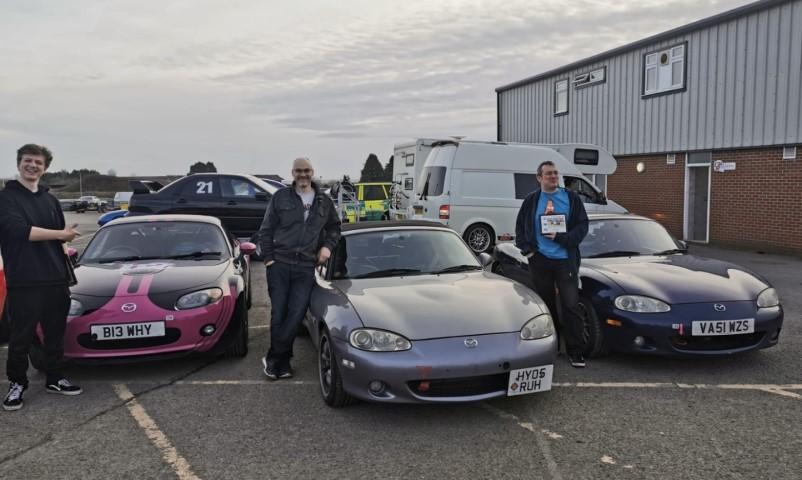
4 minute read
Ariel Factory Visit - Take Two
Every hand-built AMG Mercedes which rolls off the Affalterbach production line wears a signed badge on the engine cover. That badge commemorates for eternity the collective effort of the tens, if not hundreds, of assembly staff who contributed to the vehicle’s birth. Ariel Cars of Somerset however, take hand-built to a whole new level.
History lesson over; we were excited to see where the company are now and swiftly headed for the main build hall. On the way we stopped at one of the company’s new motorcycles; the latest Ariel Ace. Taking in the details of the quite particular front suspension arrangement, I could tell I wasn’t the only one with a keen eye for technical detail.
Advertisement
Despite the morning of Saturday December 10th feeling reserved by Jack Frost, 15 club members braved sub-zero temperatures for a tour of Ariel cars' factory in Crewkerne. As an article for the club magazine, I’m sure Ariel cars need little introduction; most of us will be familiar with the spaceframe car which tried to rip Jeremy Clarkson’s face off. Visiting behind the scenes, where the machines are built, I was keen to learn more about what makes the company tick. The tour opened with an introduction to where Ariel began, including an early Atom prototype, a wall adorned with special nosecones and a historic collection from the original Birminghambased brand. Little did I know that from 1902 until 1970, Ariel produced motorcycles and quadricycles until the badge was retired by new owners BMC.
We were invited down a short staircase and into the main assembly hall. Across the floor were 8 or so examples of the latest Atom in varying states of assembly. With them, production staff working into the cold weekend to keep up with demand, eager to welcome visitors.
Looking around, the parts awaiting assembly would look familiar to any home mechanic; chassis, suspension arms and wiring looms from local suppliers, control surfaces and brakes from wellknown brands and an array of carbon fibre body panels including front and rear wings and seats. At the heart of each Atom is a crate engine supplied from the Honda Civic Type R.
That’s where the comparison to the familiar ends however. Integrated together, these parts form one of the lightest performance cars on the market capable of out-accelerating almost anything else with four wheels on the road. Unlike competition cars built for uncompromising performance, the Atom is also made to drive home in relative comfort; adhering to all the rules and regulations which govern all cars on the public highway. As such, before being released to paying customers, each vehicle is subject to an Individual Vehicle Approval (IVA). Challenging enough for vehicles destined for the UK but only made more complicated by an expanding international customer base – indeed one of the cars on the floor was destined for export to New Zealand. feel is best, based on the time, resources and parts available, even personal preference. Unlike a conventional build process, looking across the floor, there was no way of knowing what was done most recently nor what happens next. One car was sat on axle stands with suspension arms fitted however a prominent void awaiting a powerplant which was sat nearby on a crate. Another was already fitted with it's internalcombustion heart but missing any suspension arms. When quizzed on why, the assembler openly explained that he feels more comfortable fitting the engine before the suspension to avoid scraped knees and awkward postures reaching into the engine bay.
Quite a feat for a design team of just 6 engineers and a demonstration that collaboration with suppliers is key to developing the product. (For comparison the average F1 team have at least 40 engineers building 2 track-only cars a year).
Ariel builds around 50 cars a year with a 2 week build period for each. I thought I had a reasonable grasp of small volume manufacture; and arrived expecting to find cars marching along an assembly line supported by meticulously documented descriptions of every intricate step of the process.
His colleague meanwhile didn't face such challenges and had enough time on Friday to fit the engine so went ahead. Whilst a surprising departure from the rigidity I was expecting, the benefits of this flexible approach are clear to see. Ariel have been able to weather the supply-chain issues affecting larger, traditional manufacturers, and continue to offer truly hand-made cars to the market.
Ariel however, do things a little differently: The responsibility for assembling each vehicle belongs to just one person. Everyone on the floor is trained in, and will eagerly take on, every step of the process. Each team member assembles each vehicle in the order they
Moving on from the assembly hall, we headed for the customer service building containing a number of fullymanufactured road-going vehicles. Firstly, Ariel’s road test fleet including several special vehicles. We were particularly drawn to an Atom with a frame manufactured from titanium showcasing the company’s continuing exploration of what can be done with their already unique product. This example however proved prohibitively expensive to put into production demonstrating the constraints which apply even in such a specialist corner of the automotive marketplace. doors to the motor club, welcoming us in with open arms, candid conversation from the skilled individuals on the shop floor, even donating the tour fee to charity. Everyone involved appeared proud to be working on something special and showcase their operations. At an organisational level, the company challenge the mould set by faceless production lines pumping out carboncopies of the same car. Long may Ariel’s hands-on approach remain into their fully electric age with their upcoming Hipercar and beyond.
The tour ended in the customer service hall. Like any good maintenance facility, there were vehicles in for a range of operations from regular servicing of the Nomad press car to an Atom in for conversion from left to right hand drive.

Club members gladly took the opportunity to pour over the details of finished vehicles, from distinct paintwork to unique options to aftermarket modifications. A few even took it in turns attempting to find a dignified way in or out of the Ariel Nomad famously driven by Freddie Flintoff. Before we had any success with that though, our time at Ariel had come to an end and we were back out in the cold ready to head home but not before lunch…
Reflecting together over a hearty meal, I realised how truly hand-built Ariel cars are. Unlike other automotive factories, there wasn’t one robot working the line. It’s often said that products reflect the culture in which they're developed. In that context, Ariel becomes a beacon of pride; proud to hand-build their vehicles. The company proudly opened their







